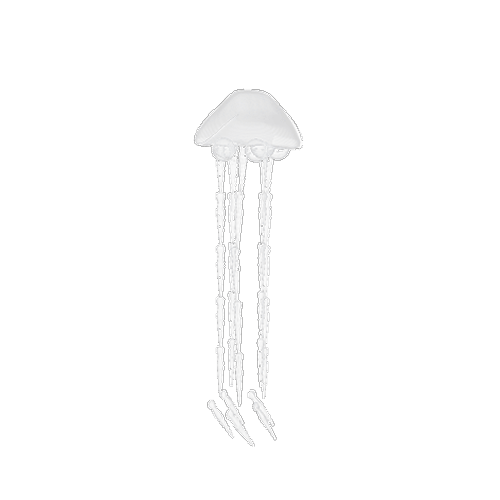SIHUI
数据海洋——
电子游牧生物
Data Ocean -
Electronic Nomadic creatures
AR Experience, Concept Video | 2020 | Team Project
Starting from the phenomena of virtual social networking and digital nomadism, we observe that events within virtual social networks reflect a series of online behaviors, collectively illustrating the social and biological dimensions of digital interactions. These behaviors serve as a mirror to real-life dynamics. Inspired by Solaris, we constructed a "Data Ocean," a metaphor for the virtual social space. Within this ocean, the subjects of virtual interactions are abstracted into electronic nomadic creatures, embodying biological traits and behavioral patterns as they wander, exchange information, and evolve within the data ocean.
Using augmented reality technology, the Data Ocean is projected into physical space, merging the characteristics of these organisms with the spatial properties of urban environments, particularly in cities where information is densely processed. This work explores new possibilities for human existence in a future of infinite data interconnectivity.




Poster






































Screen Recording of AR Experience
Introduction of Nomadic Creatures
In collaboration with EZXR, we utilized “网易洞见”app as the platform to visualize the Electronic Nomadic Creatures, with Qianjiang Century Park serving as the testing and exhibition space.
Through augmented reality technology, the Data Ocean is projected into physical space, merging the traits of these creatures with the spatial characteristics of urban environments. They cluster in cities where information is densely processed, exploring the interplay between digital and physical realities.
Human virtual network behaviors are visualized as biological activities in physical space, revealing a dynamic ecosystem.






Parasitic Creatures
Aggressive in nature, with irregularly extending and retracting spikes. The outer host relies on external energy absorption. Often found in hidden areas such as dark corners or crevices.
Defensive Creatures
Mildly aggressive, typically inhabiting various water bodies. They generate energy by absorbing light and use their tentacles to grasp objects or attack other creatures for self-protection. Unable to survive without water and light.
Reproductive Creatures
Colonial marine plants with no aggressive traits. They thrive in shallow waters, remaining in a constant state of growth year-round. Sunlight is essential for their survival and reproduction, leading them to cluster in sunlit coastal areas.
Predatory Creatures
Highly aggressive, equipped with compound eyes for hunting prey. Agile and elusive, their sharp tentacles can easily pierce the shells of other creatures. Commonly found on flat terrains.





Mutative Creatures
When two individuals come into contact, the creature with more information transfers its form to the one with less, resulting in gradual morphological fusion. They appear in tiered spaces, where higher levels are information-rich zones. Information transfer occurs as they move between tiers.
Ambush Creatures
Strongly aggressive, with flexible tentacles and spherical tips that secrete a corrosive mucus membrane. While effective for engulfing and dissolving other creatures, the mucus evaporates under sunlight, making them prefer lurking in dark areas.
Autophagic Creatures
Typically marine-dwelling organisms inhabiting coastal zones. When facing transient survival stress due to nutrient or energy scarcity, they degrade their own non-essential components to sustain metabolic functions.
Intraspecies Competitive Creatures
Engage in perpetual Darwinian struggles within their species — only the dominant individuals survive and reproduce. These conflicts erupt wherever critical resources (sustenance or reproductive grounds) exist.










Process
Starting from the phenomena of virtual social networking and digital nomadism, we observe that events within virtual social networks reflect a series of online behaviors. These behaviors collectively illustrate the social and biological dimensions of digital interactions, serving as a mirror to real-life dynamics.

| Research
|Discover Issues
-
Youth Social Behaviors & Spaces
-
"Nomadic Youth"
-
"Digital Nomads"
-
Youth predominantly engage in virtual social networking.
-
Nomadic youth experience a weak sense of belonging in urban spaces.
-
Digital nomadism transcends physical boundaries.
Inspired by Solaris, we constructed a "Data Ocean," a metaphor for the virtual social space. Within this ocean, the subjects of virtual interactions are abstracted into electronic nomadic creatures, embodying biological traits and behavioral patterns as they wander, exchange information, and evolve within the data ocean.

|Clues
|Questions Raised
-
Speculative Design Approach
-
Solaris, a science fiction novel.
-
Will digital nomadism become the norm in the future?
-
Are there parallels between virtual social networks and biological societies?
-
Could virtual spaces become a new realm for human existence?
Using AR technology, the Data Ocean is projected into physical space, merging the characteristics of these organisms with the spatial properties of urban environments, particularly in cities where information is densely processed. This work explores new possibilities for human existence in a future of infinite data interconnectivity.
| Approach
|Expression

-
Constructing the "Data Ocean" as a metaphor for virtual social networks.
-
Exploring parallels between virtual social behaviors and biological social behaviors.
-
Using augmented reality technology to project the "Data Ocean" into physical space. By scanning the city with a smartphone, users can observe the roaming "Electronic Nomadic Creatures."
Prevue
In collaboration with EZXR, we utilized “网易洞见”app as the platform to visualize the Electronic Nomadic Creatures, with Qianjiang Century Park serving as the testing and exhibition space.
Through augmented reality technology, the Data Ocean is projected into physical space, merging the traits of these creatures with the spatial characteristics of urban environments. They cluster in cities where information is densely processed, exploring the interplay between digital and physical realities.
Human virtual network behaviors are visualized as biological activities in physical space, revealing a dynamic ecosystem.
-min_gif.gif)
-min_gif.gif)
-min_gif.gif)
In collaboration with EZXR, we utilized “网易洞见”app as the platform to visualize the Electronic Nomadic Creatures, with Qianjiang Century Park serving as the testing and exhibition space.
Through augmented reality technology, the Data Ocean is projected into physical space, merging the traits of these creatures with the spatial characteristics of urban environments. They cluster in cities where information is densely processed, exploring the interplay between digital and physical realities.
Human virtual network behaviors are visualized as biological activities in physical space, revealing a dynamic ecosystem.








